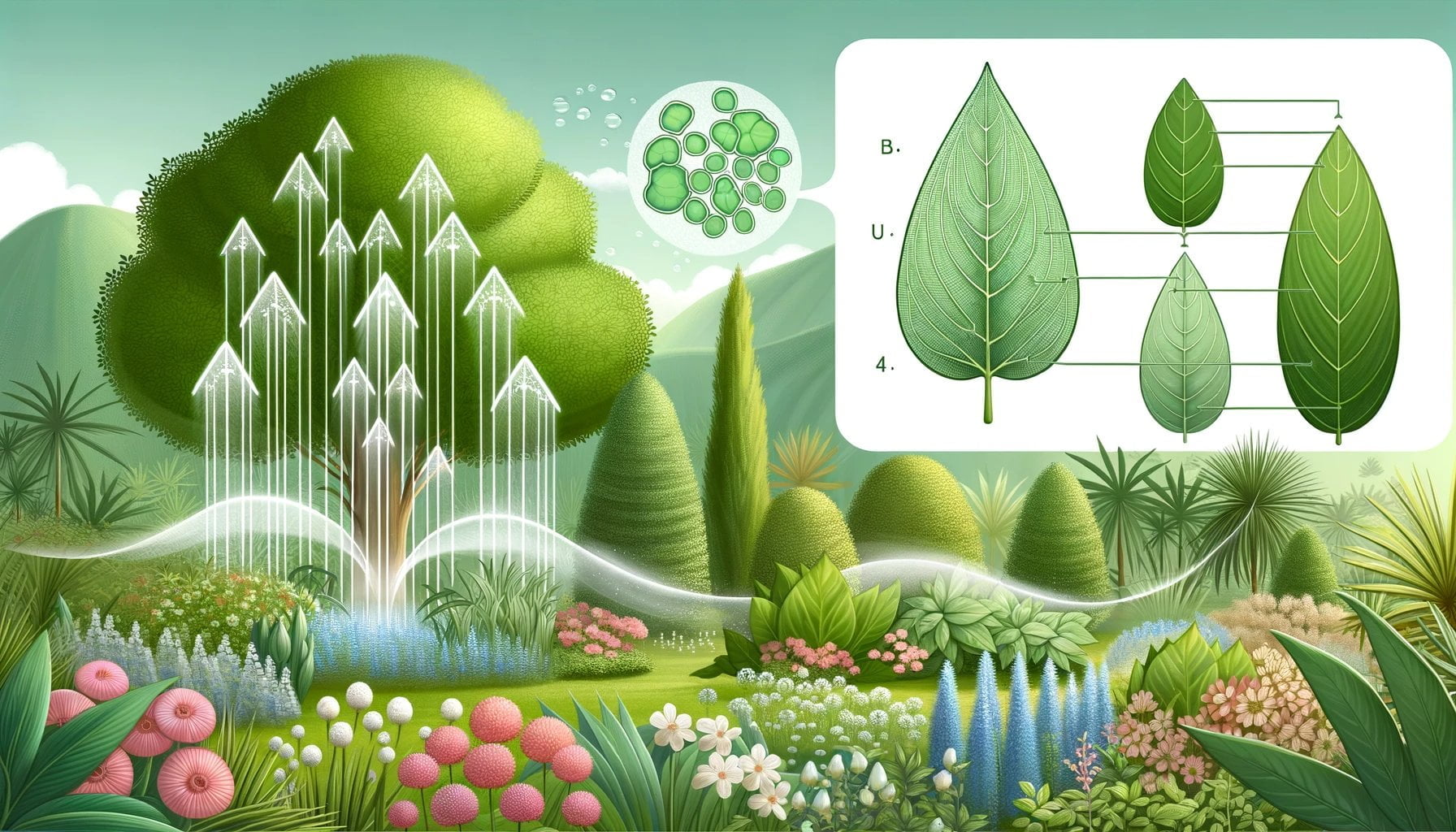In the intricate web of Earth’s natural processes, one fundamental mechanism stands out as a vital player: transpiration. So, what exactly is transpiration and what function does it serve in the grand scheme of things? Transpiration refers to the process by which plants lose water through their leaves. This might seem like a simple occurrence, but its significance within global water and nutrient cycles, as well as its impact on plant health and ecosystem sustainability, cannot be overstated. In this article, we’ll dive into the mechanics of transpiration, unravel its function, and explore its crucial role in maintaining the delicate balance of our natural world.
What is Transpiration and its Function?
Transpiration is a crucial process in plant physiology that involves the evaporation of water from the aerial parts of the plant, such as leaves, stems, and flowers. It serves multiple important functions that are essential for the overall health and sustainability of plants and ecosystems.
1. Absorption and Movement of Water: Transpiration plays a significant role in the absorption and upward movement of water in plants. As plants take in more water than they actually need at a given time, transpiration allows them to remove excess water and maintain a suitable moisture balance. This process ensures that plants have a continuous supply of water to support their vital functions.
2. Transportation of Dissolved Minerals: Another crucial function of transpiration is its role in facilitating the movement of dissolved minerals from the roots to the leaves. The upward movement of water through the plant, driven by transpiration, creates a flow of nutrients from the roots to the entire plant, ensuring proper nourishment and growth.
3. Temperature Regulation: Transpiration helps regulate the temperature of the plant, acting like a natural cooling system. Just like humans sweat to cool down, plants transpire to release excess heat and maintain their internal temperature within a suitable range. This cooling effect is especially important during hot weather conditions when plants can be at risk of overheating.
4. Removal of Excess Water: Plants often absorb more water than they need, and transpiration allows them to get rid of this excess water. By releasing water vapor through the tiny openings called stomata on their leaves, plants prevent waterlogging and maintain a balanced water content in their tissues.
5. Access to Carbon Dioxide: Transpiration also enables plants to access the carbon dioxide necessary for photosynthesis. As water is released through transpiration, it creates a “pulling force” known as the transpiration stream that draws carbon dioxide from the surrounding atmosphere into the leaves. This carbon dioxide is crucial for the plant’s ability to convert light energy into chemical energy and produce the sugars necessary for growth and development.
Transpiration occurs through two main pathways: stomatal transpiration and cuticular transpiration. Stomatal transpiration is the most common form and occurs through the stomata present on the surface of leaves. Cuticular transpiration, on the other hand, happens through the waxy cuticle that covers the surface of plants. These different pathways of transpiration allow plants to modulate the rate at which water evaporates, depending on their environmental conditions and water availability.
In summary, transpiration is a vital process for plant survival and ecosystem functioning. It helps plants absorb and transport water and minerals, regulates temperature, provides a means to remove excess water, and enables the vital exchange of carbon dioxide for photosynthesis. Understanding transpiration and its function is crucial in appreciating the remarkable adaptability and resilience of plant life in various environments.
Transpiration, an essential process in the water cycle, plays a crucial role in the movement of water through plants. It involves the release of water vapor from plant leaves into the atmosphere. Transpiration helps plants absorb nutrients and minerals from the soil and aids in cooling the plant’s surface. The intricate balance of roots absorbing water and leaves releasing water vapor creates a continuous flow within the plant, contributing to the overall circulation of water in the ecosystem. Explore more about transpiration in the water cycle here.
The Functions of Transpiration
Transpiration is a fascinating process that plays a crucial role in plant physiology and ecosystem sustainability. This article will explore the functions of transpiration, shedding light on its significance in plant health, the global water and nutrient cycles, and the regulation of temperature within plants.
Transportation of Water and Minerals
One of the primary functions of transpiration is the transportation of water and minerals from the roots to the leaves of plants. Through this process, plants ensure that they receive the necessary nutrients for growth and survival. The transportation of water and minerals occurs through special vascular tissues called xylem.
When water evaporates from the leaves during transpiration, it creates a negative pressure or suction force. This force, known as transpiration pull, helps to pull water from the roots upward through the xylem. It’s similar to how sipping through a straw causes liquid to rise. Without transpiration, water and minerals would not be able to reach the various parts of the plant, hampering essential metabolic processes.
Cooling and Regulation of Temperature
Transpiration also acts as a natural cooling system for plants and plays a vital role in regulating their temperature. As water evaporates from the leaves, it releases heat energy. This process helps to dissipate excess heat, preventing the plant from overheating.
Think of transpiration as a plant’s very own air conditioning system. Just as we sweat to cool down, plants transpire to maintain an optimal temperature for their metabolic processes. Without transpiration, plants would be more susceptible to heat stress and may not be able to function efficiently.
Maintaining Plant Health and Functioning
The functions of transpiration are essential for the overall health and functioning of plants. It promotes efficient absorption and movement of water and minerals, ensuring that plants receive the nourishment they need to grow and thrive. Transpiration also aids in maintaining the moisture balance within plants, preventing waterlogging and potential damage.
Additionally, transpiration enables plants to access carbon dioxide, a crucial component for photosynthesis. By opening tiny pores called stomata on their leaves, plants take in carbon dioxide from the atmosphere, utilizing it to produce sugars and other vital compounds for their growth and development.
Understanding the intricate functions of transpiration allows us to appreciate the resilience and adaptability of plants in various environments. From hot, arid regions to humid tropical rainforests, plants have evolved unique mechanisms to regulate transpiration rates, ensuring their survival and success.
To summarize, transpiration serves as a vital vehicle for transporting water and minerals within plants while also contributing to their temperature regulation. By maintaining a delicate balance between water uptake and loss, transpiration supports the health and productivity of plants, ultimately impacting the sustainability of ecosystems.
Functions of Transpiration: Pros and Cons
| Pros of Transpiration | Cons of Transpiration |
|---|---|
| Facilitates nutrient absorption and distribution | Leads to water loss from plants |
| Assists in temperature regulation | Can make plants more vulnerable to drought |
| Enables the acquisition of CO2 for photosynthesis | Can increase the risk of wilting in certain conditions |
| Maintains optimal moisture balance | Requires energy expenditure from the plant |
As with any natural process, transpiration comes with both advantages and disadvantages. While it enables essential functions in plants, such as nutrient absorption, temperature regulation, and CO2 acquisition, it also results in water loss and can make plants more susceptible to drought and wilting.
Understanding the functions of transpiration equips us with the knowledge to appreciate the delicate interplay between plants and their environment. It highlights the remarkable adaptations and strategies that plants employ to thrive in diverse ecosystems worldwide.
Importance of Transpiration in Plants and Ecosystems
Transpiration, the process by which plants lose water through their leaves, plays a crucial role in the survival and functioning of plants and ecosystems. It serves as a mechanism for the conduction of water and minerals to different parts of the plant, maintaining a balance of water within the plant and promoting the overall health and sustainability of ecosystems. In this article, we will delve deeper into the significance of transpiration and explore its various functions.
The Transportation of Water and Minerals
One of the primary functions of transpiration is the transportation of water and minerals from the roots to the leaves of plants. This process occurs through specialized vascular tissues called xylem. As water evaporates from the leaves, a phenomenon known as transpiration pull is created. This pull helps draw water from the roots upward through the xylem, allowing it to reach the leaves and other parts of the plant where it is needed for crucial life processes.
Natural Cooling System
Transpiration also acts as a natural cooling system for plants. As water evaporates from the leaves, it releases heat energy, preventing the plant from overheating. This cooling effect is particularly important in hot environments where excessive heat can damage plant tissues. By regulating the temperature, transpiration ensures that plants can thrive in various climatic conditions.
Maintaining Moisture Balance
Another vital function of transpiration is maintaining the moisture balance within plants. It helps prevent waterlogging, which can lead to root damage and hinder the absorption of essential nutrients. By facilitating the release of excess water through the release of water vapor, transpiration ensures that plants have just the right amount of moisture to support their growth and development.
Carbon Dioxide Acquisition
Transpiration plays a crucial role in the acquisition of carbon dioxide (CO2) necessary for photosynthesis. Photosynthesis is the process by which plants convert CO2 and sunlight into energy-rich molecules. Through the opening of tiny pores on the surface of leaves known as stomata, transpiration enables the entry of CO2 into the plant, fueling the photosynthetic process. This ensures that plants can produce the energy they need to carry out essential metabolic activities.
Pros and Cons of Transpiration
While transpiration provides several benefits, it also comes with certain drawbacks. Let’s explore the pros and cons of this process:
Pros
- Facilitates Nutrient Absorption: Transpiration helps transport dissolved minerals from the roots to the leaves, ensuring the proper nourishment and growth of plants.
- Temperature Regulation: By releasing heat energy, transpiration prevents plants from overheating, allowing them to survive in a wide range of environmental conditions.
- CO2 Acquisition: Through stomatal openings, transpiration enables the entry of CO2, which is essential for photosynthesis and the production of plant energy.
Cons
- Water Loss: Transpiration results in the loss of water through evaporation, which can be detrimental in arid environments or during drought conditions.
- Vulnerability to Drought and Wilting: Excessive transpiration without sufficient water uptake can lead to water stress, drought, and wilting in plants.
In conclusion, transpiration plays a vital role in the overall health and sustainability of plants and ecosystems. It serves as a transportation mechanism for water and minerals, acts as a natural cooling system, helps maintain the moisture balance within plants, and facilitates the acquisition of carbon dioxide for photosynthesis. By understanding the importance of transpiration, we can appreciate the adaptability and resilience of plants in different environments and work towards their conservation and sustainable management.
FAQ
Question 1
What is transpiration and why is it important for plants?
Answer 1
Transpiration is the evaporation of water from the aerial parts of plants, such as leaves, stems, and flowers. It serves several important functions for plants, including helping in the absorption and upward movement of water, facilitating the transportation of dissolved minerals from the roots to leaves, regulating the plant’s temperature, allowing plants to get rid of excess water, and enabling the plants to access the carbon dioxide needed for photosynthesis. Transpiration is crucial for the survival and productivity of plants as it helps in the conduction of water and minerals, maintains water balance, supports osmosis and cell rigidity, facilitates gas exchange, and aids in the transport of mineral salts.
Question 2
How does transpiration contribute to the transportation of water and minerals in plants?
Answer 2
Transpiration plays a key role in the transportation of water and minerals in plants. It helps in the movement of water and minerals from the roots to the leaves through the xylem. This process is facilitated by transpiration pull, where water is pulled upward due to the evaporation of water from the leaves. By creating a negative pressure gradient, transpiration pull helps in the conduction of water and minerals throughout the plant’s vascular system.
Question 3
What is the role of transpiration in the cooling and regulation of plant temperature?
Answer 3
Transpiration is essential for the cooling and regulation of plant temperature. As water evaporates from the leaves during transpiration, it releases heat energy, thus cooling the plant. This cooling effect is crucial for maintaining the optimal temperature required for various metabolic processes in plants. By dissipating excess heat through transpiration, plants are able to prevent overheating and maintain a favorable temperature for their growth and functioning.
Question 4
How does transpiration help in maintaining the health and functioning of plants?
Answer 4
Transpiration is important for the overall health and functioning of plants in multiple ways. It facilitates the absorption and movement of water and minerals, allowing plants to meet their essential nutrient requirements. Transpiration also helps in maintaining the balance of water within the plant, ensuring proper cell turgidity and osmosis. Additionally, it aids in the exchange of gases, such as carbon dioxide, which is crucial for photosynthesis. By enabling the removal of excess water, transpiration helps prevent waterlogging and maintains a favorable internal environment for plant growth. Furthermore, transpiration supports the development of the plant body by absorbing and distributing water to different plant parts.
Question 5
What are the different types of transpiration and their significance?
Answer 5
There are two main types of transpiration: stomatal transpiration and cuticular transpiration. Stomatal transpiration occurs through the stomata, which are small openings on the leaves, regulating the exchange of gases and water vapor between the plant and the atmosphere. This form of transpiration is the most common and plays a crucial role in plant physiology. Cuticular transpiration, on the other hand, occurs through the cuticle, which is the waxy layer covering the aerial parts of plants. While it is generally less significant compared to stomatal transpiration, cuticular transpiration contributes to water loss and is particularly important in certain plant species, such as desert plants, for reducing water loss in hot and arid environments.

















